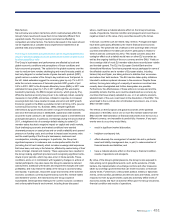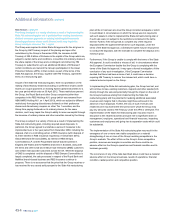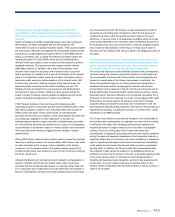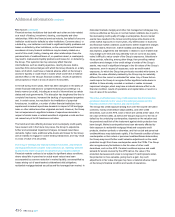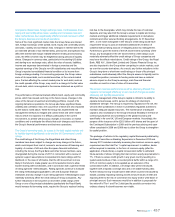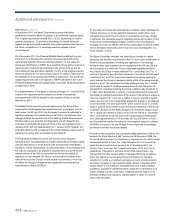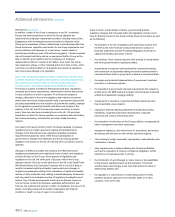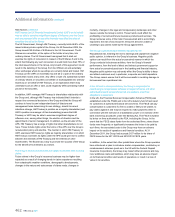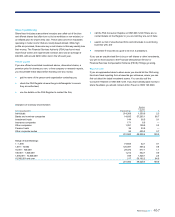RBS 2011 Annual Report Download - page 459
Download and view the complete annual report
Please find page 459 of the 2011 RBS annual report below. You can navigate through the pages in the report by either clicking on the pages listed below, or by using the keyword search tool below to find specific information within the annual report.
RBS Group 2011 457
Changes in interest rates, foreign exchange rates, credit spreads, bond,
equity and commodity prices, basis, volatility and correlation risks and
other market factors have significantly affected and will continue to affect
the Group’s business and results of operations
Some of the most significant market risks the Group faces are interest
rate, foreign exchange, credit spread, bond, equity and commodity prices
and basis, volatility and correlation risks. Changes in interest rate levels
(or extended periods of low interest rates), yield curves and spreads may
affect the interest rate margin realised between lending and borrowing
costs, the effect of which may be heightened during periods of liquidity
stress. Changes in currency rates, particularly in the sterling-US dollar
and sterling-euro exchange rates, affect the value of assets, liabilities,
income and expenses denominated in foreign currencies and the
reported earnings of the Group’s non-UK subsidiaries and may affect the
Group’s reported consolidated financial condition or its income from
foreign exchange dealing. For accounting purposes, the Group values
some of its issued debt, such as debt securities, at the current market
price. Factors affecting the current market price for such debt, such as
the credit spreads of the Group, may result in a change to the fair value
of such debt, which is recognised in the income statement as a profit or
loss.
The performance of financial markets affects bond, equity and commodity
prices, which has caused, and may in the future cause, changes in the
value of the Group’s investment and trading portfolios. As part of its
ongoing derivatives operations, the Group also faces significant basis,
volatility and correlation risks, the occurrence of which are also impacted
by the factors noted above. While the Group has implemented risk
management methods to mitigate and control these and other market
risks to which it is exposed, it is difficult, particularly in the current
environment, to predict with accuracy changes in economic or market
conditions and to anticipate the effects that such changes could have on
the Group’s financial performance and business operations.
The Group’s borrowing costs, its access to the debt capital markets and
its liquidity depend significantly on its and the UK Government’s credit
ratings
The credit ratings of the Group, the Royal Bank and other Group
members have been subject to change and may change in the future,
which could impact their cost of, access to and sources of financing and
liquidity. A number of UK and other European financial institutions,
including the Group, the Royal Bank and other Group members, were
downgraded during the course of 2011 in connection with a review of
systemic support assumptions incorporated into bank ratings and the
likelihood, in the case of UK banks, that the UK Government is more
likely in the future to make greater use of its resolution tools to allow
burden sharing with bondholders, and in connection with a general review
of rating agencies’ methodologies. Rating agencies continue to evaluate
the rating methodologies applicable to UK and European financial
institutions and any change in such rating agencies’ methodologies could
materially adversely affect the credit ratings of Group companies. Any
further reductions in the long-term or short-term credit ratings of the
Group or one of its principal subsidiaries (particularly the Royal Bank)
would increase its borrowing costs, require the Group to replace funding
lost due to the downgrade, which may include the loss of customer
deposits, and may also limit the Group’s access to capital and money
markets and trigger additional collateral requirements in derivatives
contracts and other secured funding arrangements. At 31 December
2011, a one notch downgrade in the Group’s credit rating would have
required the Group to post an estimated additional £12.5 billion of
collateral without taking account of mitigating action by management.
Furthermore, given the extent of the UK Government ownership of the
Group, any downgrade in the UK Government’s credit ratings could
materially adversely affect the credit ratings of Group companies and
may have the effects noted above. Credit ratings of the Group, the Royal
Bank, RBS N.V., Ulster Bank Limited and Citizens Financial Group Inc.
are also important to the Group when competing in certain markets, such
as over-the-counter derivatives. As a result, any further reductions in the
Group’s long-term or short-term credit ratings or those of its principal
subsidiaries could adversely affect the Group’s access to liquidity and its
competitive position, increase its funding costs and have a material
adverse impact on the Group’s earnings, cash flow and financial
condition or result in a loss of value of its securities.
The Group’s business performance could be adversely affected if its
capital is not managed effectively or as a result of changes to capital
adequacy and liquidity requirements
Effective management of the Group’s capital is critical to its ability to
operate its businesses, and to pursue its strategy of returning to
standalone strength. The Group is required by regulators in the UK, the
US and other jurisdictions in which it undertakes regulated activities to
maintain adequate capital resources. The maintenance of adequate
capital is also necessary for the Group’s financial flexibility in the face of
continuing turbulence and uncertainty in the global economy and
specifically in its core UK, US and European markets. Accordingly, the
purpose of the issuance of the £25.5 billion of B shares and the grant of
the Contingent Subscription in 2009 and the previous placing and open
offers completed in 2008 and 2009 was to allow the Group to strengthen
its capital position.
The package of reforms to the regulatory capital framework published by
the Basel Committee on Banking Supervision in December 2010 and
January 2011 includes materially increasing the minimum common equity
requirement and the total Tier 1 capital requirement. In addition, banks
will be required to maintain, in the form of common equity (after the
application of deductions), a capital conservation buffer to withstand
future periods of stress, bringing the total common equity requirements to
7%. If there is excess credit growth in any given country resulting in a
system-wide build-up of risk, a countercyclical buffer within a range of 0-
2.5% of common equity is to be applied as an extension of the
conservation buffer. In addition, a leverage ratio will be introduced,
together with a liquidity coverage ratio and a net stable funding ratio.
Further measures may include bail-in debt which could be introduced by
statute, possibly impacting existing as well as future issues of debt and
exposing them to the risk of conversion into equity and/or write-down of
principal amount. Such measures would be in addition to proposals for
the write-off of Tier 1 and Tier 2 debt (and its possible conversion into
ordinary shares) if a bank becomes non-viable.






